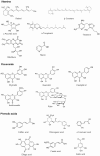Cultivation, Genetic, Ethnopharmacology, Phytochemistry and Pharmacology of Moringa oleifera Leaves: An Overview
- PMID: 26057747
- PMCID: PMC4490473
- DOI: 10.3390/ijms160612791
Cultivation, Genetic, Ethnopharmacology, Phytochemistry and Pharmacology of Moringa oleifera Leaves: An Overview
Abstract
Moringa oleifera is an interesting plant for its use in bioactive compounds. In this manuscript, we review studies concerning the cultivation and production of moringa along with genetic diversity among different accessions and populations. Different methods of propagation, establishment and cultivation are discussed. Moringa oleifera shows diversity in many characters and extensive morphological variability, which may provide a resource for its improvement. Great genetic variability is present in the natural and cultivated accessions, but no collection of cultivated and wild accessions currently exists. A germplasm bank encompassing the genetic variability present in Moringa is needed to perform breeding programmes and develop elite varieties adapted to local conditions. Alimentary and medicinal uses of moringa are reviewed, alongside the production of biodiesel. Finally, being that the leaves are the most used part of the plant, their contents in terms of bioactive compounds and their pharmacological properties are discussed. Many studies conducted on cell lines and animals seem concordant in their support for these properties. However, there are still too few studies on humans to recommend Moringa leaves as medication in the prevention or treatment of diseases. Therefore, further studies on humans are recommended.
Keywords: Moringa oleifera; breeding; cancer; diabetes; dislipidemia; ethnopharmacology; genetic variability; molecular markers; pharmacology; phytochemistry.
Figures
Similar articles
-
Moringa oleifera: a valuable insight into recent advances in medicinal uses and pharmacological activities.J Sci Food Agric. 2023 Dec;103(15):7343-7361. doi: 10.1002/jsfa.12892. Epub 2023 Aug 17. J Sci Food Agric. 2023. PMID: 37532676 Review.
-
Antioxidant properties of various solvent extracts of total phenolic constituents from three different agroclimatic origins of drumstick tree (Moringa oleifera Lam.) leaves.J Agric Food Chem. 2003 Apr 9;51(8):2144-55. doi: 10.1021/jf020444+. J Agric Food Chem. 2003. PMID: 12670148
-
A Protein Isolate from Moringa oleifera Leaves Has Hypoglycemic and Antioxidant Effects in Alloxan-Induced Diabetic Mice.Molecules. 2017 Feb 11;22(2):271. doi: 10.3390/molecules22020271. Molecules. 2017. PMID: 28208654 Free PMC article.
-
Moringa oleifera in a modern time: A comprehensive review of its nutritional and bioactive composition as a natural solution for managing diabetes mellitus by reducing oxidative stress and inflammation.Food Res Int. 2025 Feb;201:115671. doi: 10.1016/j.foodres.2025.115671. Epub 2025 Jan 4. Food Res Int. 2025. PMID: 39849793 Review.
-
Effects of Drying Temperature and Solvents on In Vitro Diabetic Wound Healing Potential of Moringa oleifera Leaf Extracts.Molecules. 2023 Jan 11;28(2):710. doi: 10.3390/molecules28020710. Molecules. 2023. PMID: 36677768 Free PMC article.
Cited by
-
Crop Improvement of Moringa oleifera L. through Genotype Screening for the Development of Clonal Propagation Techniques of High-Yielding Clones in Malaysia.Biology (Basel). 2024 Sep 30;13(10):785. doi: 10.3390/biology13100785. Biology (Basel). 2024. PMID: 39452094 Free PMC article.
-
A Comprehensive Review with Updated Future Perspectives on the Ethnomedicinal and Pharmacological Aspects of Moringa oleifera.Molecules. 2022 Sep 6;27(18):5765. doi: 10.3390/molecules27185765. Molecules. 2022. PMID: 36144493 Free PMC article. Review.
-
Effect of Solid-State Fermentation on Nutritional Quality of Leaf Flour of the Drumstick Tree (Moringa oleifera Lam.).Front Bioeng Biotechnol. 2021 Apr 12;9:626628. doi: 10.3389/fbioe.2021.626628. eCollection 2021. Front Bioeng Biotechnol. 2021. PMID: 33912544 Free PMC article.
-
Moringa oleifera L. Extracts as Bioactive Ingredients That Increase Safety of Body Wash Cosmetics.Dermatol Res Pract. 2020 Jul 1;2020:8197902. doi: 10.1155/2020/8197902. eCollection 2020. Dermatol Res Pract. 2020. PMID: 32695156 Free PMC article.
-
An insight into the neuroprotective and anti-neuroinflammatory effects and mechanisms of Moringa oleifera.Front Pharmacol. 2023 Jan 5;13:1035220. doi: 10.3389/fphar.2022.1035220. eCollection 2022. Front Pharmacol. 2023. PMID: 36686668 Free PMC article. Review.
References
-
- Paliwal R., Sharma V. A review on horse radish tree (Moringa oleifera): A multipurpose tree with high economic and commercial importance. Asian J. Biotechnol. 2011;3:317–328. doi: 10.3923/ajbkr.2011.317.328. - DOI
-
- Sharma V., Paliwal R., Sharma P., Sharma S. Phytochemical analysis and evaluation of antioxidant activities of hydro-ethanolic extract of Moringa oleifera Lam. pods. J. Pharm. Res. 2011;4:554–557.
-
- Roloff A., Weisgerber H., Lang U., Stimm B. Enzyklopädie der Holzgewächse, Handbuch und Atlas der Dendrologie. WILEY-VCH; Weinheim, Germany: 2009.
-
- Ganguly S. Indian ayurvedic and traditional medicinal implications of indigenously available plants, herbs and fruits: A review. Int. J. Res. Ayurveda Pharm. 2013;4:623–625. doi: 10.7897/2277-4343.04435. - DOI
-
- Mutheeswaran S., Pandikumar P., Chellappandian M., Ignacimuthu S. Documentation and quantitative analysis of the local knowledge on medicinal plants among traditional Siddha healers in Virudhunagar district of Tamil Nadu, India. J. Ethnopharmacol. 2011;137:523–533. doi: 10.1016/j.jep.2011.06.003. - DOI - PubMed
Publication types
MeSH terms
Substances
LinkOut - more resources
Full Text Sources
Other Literature Sources
Medical



